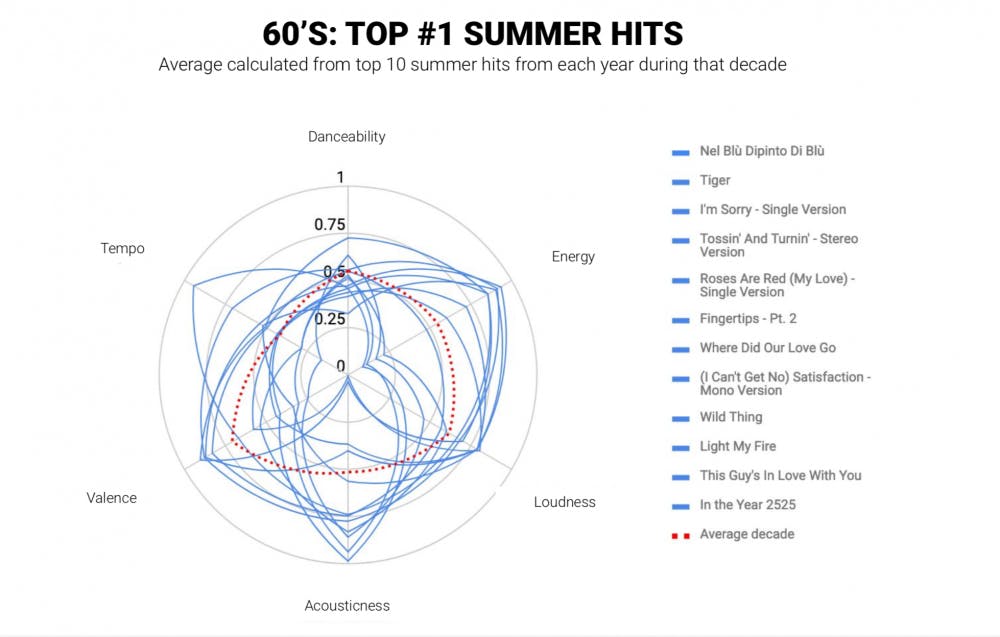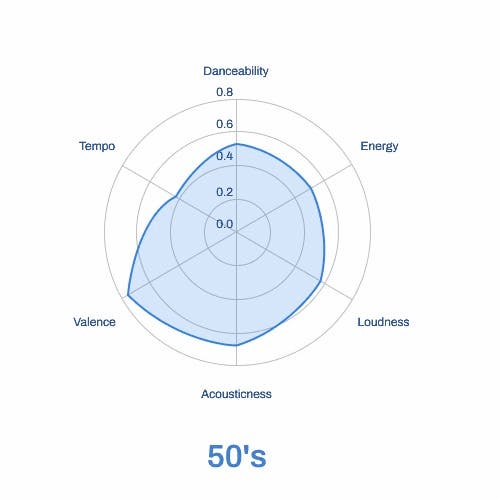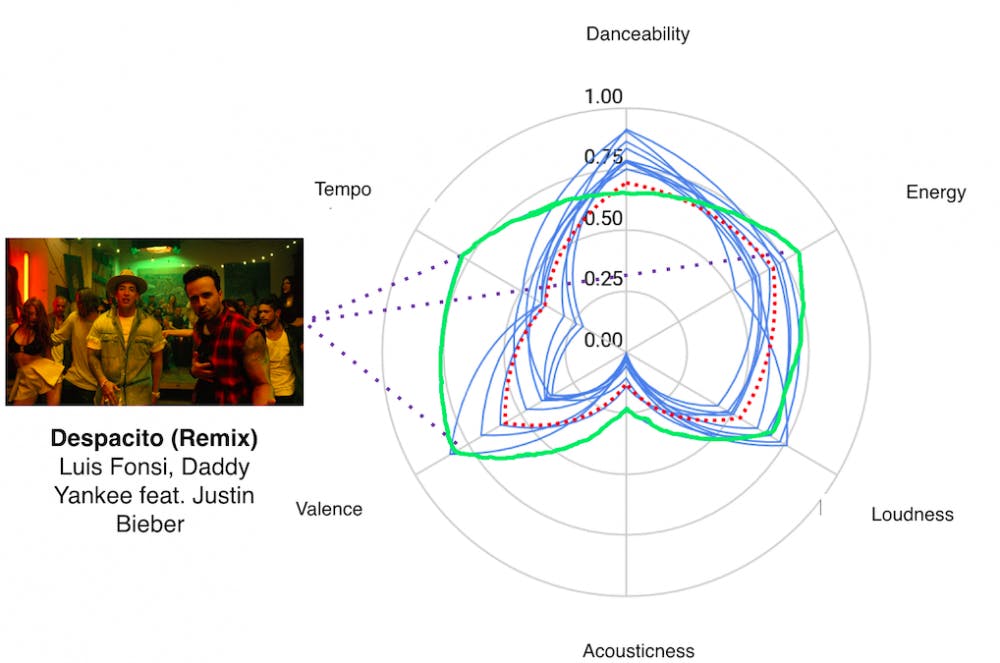Big Data
Sonarworks, as you may or may not know, is essentially a research company. They have studied tens of thousands of listeners’ sonic preferences, hundreds of headphones’ frequency responses, tens of thousands of studios’ monitor systems, and room acoustic responses. All this research has been put to good use in developing their SoundID Reference and SoundID apps, as well as more revolutionary products yet to come.
What makes a hit song for a particular summer? Is there some hidden code in the lyrics, melody, tempo, or other factors that can predict or even help us synthesize the next big hit? Spoiler alert: probably not. However, there is a lot of useful information to be gleaned from studying aspects of hit songs over the past half-century.
Thanks to the Billboard charts and Spotify’s Audio Analysis data, Alvaro Ager, head of Business Intelligence at Sonarworks, was able to create graphical representations of the meta tags that Spotify uses to describe the ten summer hits of each decade. For those other data nerds out there, this data was collected with the Spotify R package. More info on Spotify and other cool ways to analyze Spotify data can be found here.
A Song’s DNA Defined
Spotify, the heavyweight in song streaming, has analyzed every song’s musical content and structure to a granular level. The analysis includes tempo, key signature, modality (major/minor), time signature, loudness (LUFS), acousticness, danceability, energy, instrumentalness (lack of lyrics), liveness (live vs programmed instruments), speechiness (spoken words—like poetry or audiobooks), valence (positiveness).
For the analysis, Sonarworks looked at danceability, tempo, energy, loudness, acousticness, and valence. The parameters that were left out, and perhaps some of the included parameters, seem redundant or unnecessary. For instance, we don’t want poetry for these samples, so speechiness is unnecessary. It appears to me that energy and loudness are very closely related, and maybe both are not necessary, but both are included in these graphs. Some of this analysis only becomes obvious after the data is generated, so we will stick with the six parameters listed above.
The Graphs
An interesting visual way to represent multiple data points on a single graph is through the use of radar charts. Radar charts allow us to see similarities of data via an outline of the data points on the chart. For instance, here is a radar chart of “Shape of You,” by Ed Sheeran.

In this example, we can see “Shape of You” scores highly in valence, danceability, and also displays a good level of energy and acousticness. No weight for this song is given to liveness or speechiness. (image source: Ashrith Shetty What Makes a Song Likeable)
History Lesson
Let’s take a look at some charts of the summer hit songs from the past decades and compare them to recent summer hits. Perhaps this exercise can give us insight into how to predict the characteristics of the hits coming out this summer!

The above chart shows just how diverse a group of songs the 1960s summer hits were. The Doors’ irreverent “Light My Fire” was an extreme contrast to the saccharin orchestra-backed Domenico Modugno’s European pop hit “Nel Biu Dipinto di Blu (Volare). The average of the characteristics of all the songs shows an almost-uniform distribution between all the tags, while any individual song tended strongly toward a specific tag. In this decade there were as many songs that veered far from the average in either direction for each tag.
We see many songs leaning towards acousticness, energy, and valence while all the other categories are strongly represented. Drum machines didn’t exist in this era, but that didn’t keep the songs from scoring high in energy, loudness, and danceability. This chart shows a lot of diversity in the musical presentations of these 10 hits.
Modern Times
The chart below shows the 2010s summer hits, including Robin Thick’s throwback R&B track “Blurred Lines” and Lil Nas X’s genre-bending “Old Town Road.” These two songs stood out as unique productions for this era. More straight-ahead pop songs like “Call Me Maybe” by Carly Rae Jepsen and “California Gurls” by Katy Perry are perhaps more typical of the 2010s sound and style.
Nine out of the 10 summer hits of this decade clearly follow a pattern of danceability, energy, valence, and loudness, but more importantly, none of these songs have more than a trace of acousticness. So, despite the variety of musical styles, the production of almost all these hits follows a clearly defined blueprint, neatly hugging the average. This is in contrast to the 1960s, where the hits drifted farther away from the average rating for each category.

Reviewing the charts of the past six decades (see chart below) reveals that each decade before the 2010s demonstrated a variety of characteristics, while the 2010s demonstrates a more homogenized production aesthetic. We can also spot a strong trend away from acousticness starting in the 1990s. 1989 presented the music world with the revolutionary digital audio workstation, Sound Tools (quickly renamed Pro Tools), and music changed forever.

You may also be surprised to see the characteristic of loudness standing out in the 90s, as the digital compact disc overtook analog cassette tape sales in 1991 (and overtook vinyl in 1988). Digital recording, along with digital distribution formats led to the “Loudness Wars” of the 1990s. Loudness continues to be a trend, but we can see that loudness and energy seem to be highly correlated, and the two most recent decades have clearly trended towards energy.
Power in Numbers
So, now that we’ve seen the trends, can we ultimately predict what songs will rise to the top, or even what production styles will rise up in a given decade? It seems that technological changes have clearly changed music over the decades, especially in the acousticness category, but other descriptors, like tempo, key, valence, and modality don’t seem to have a strong-hold on any given decade.
Music, after all, is fashion and fashion changes. If this summer’s hits are uptempo, songs will surely turn downtempo within a season or two. Other descriptors, like valence, may simply be too vague of an indicator. By that, I mean that the musical positiveness of a song can come from many different aspects of the song. For instance, a jazz tune, like “Take 5” (Dave Brubeck) feels positive and uplifting despite having no lyrical message. Many classic, beloved songs could likely be hits in many different production styles.
For example, songs like Whitney Houston’s “I Will Always Love You,” or Cher’s “Do You Believe” have such strong, universal lyrical messages that they could be hits as power-ballads, dance cuts, or anything in-between. On the other hand, “Despacito,” may lose a bit of its appeal without its hypnotic reggaeton groove and classic chord progression. Sometimes production is the key and sometimes the message rules.
Lesson Learned?
What do we take away from all this? Music, as part of pop culture, conveys the messages and moods that society collectively feels. A great example of this phenomenon is the protest music of the 1960s and 70s that grew out of the world’s frustration with the Vietnam War. The mood was serious and the tempos were slow as the lyrical message ruled the song. Happier times, like in the late 1970s brought about disco, with fast tempos and messages that reflected partying.
Here is a summary of the past 6 decades overlaid on one chart. Surprisingly, the averages for each decade are not that dissimilar and the blue arrows show the trend during the 2010s, with an increase in danceability and energy and a decrease in the other areas, most notably in acousticness.

Lastly, let’s take a closer look at Luis Fonsi’s 2017 worldwide smash “Despacito.” The songwriters and producers found a formula that hit a nerve by creating a song that more widely represents every category. The other songs from this decade closely hug the average trend, more so than in any other decade.

So where does all this big data lead us? Well, if you want to write a hit song, stay away from live band productions and acousticness, and lean towards high-energy, uptempo, happy songs. Well for today, that is. Tomorrow will surely be different. Watch the news and follow the culture. Pop music closely reflects the zeitgeist of a period of time. If you’re a music fan rather than a creator, rest assured music will always be changing and evolving.
Enjoy this summer and the music it brings and rest assured that you will be surprised by a few standout hits while the majority of music evolves slowly. Keep on listening and creating and Sonarworks will keep on analyzing and building data-driven tools to enhance your experience and creativity!




